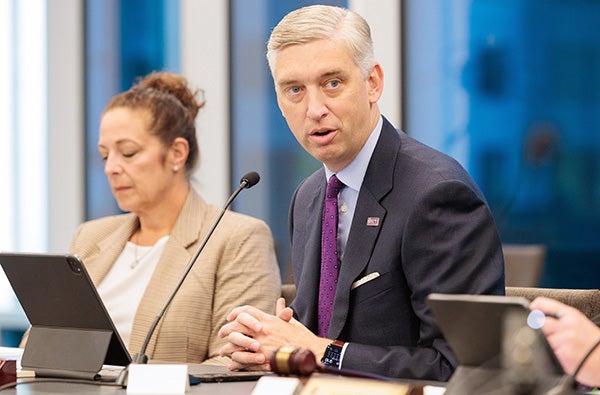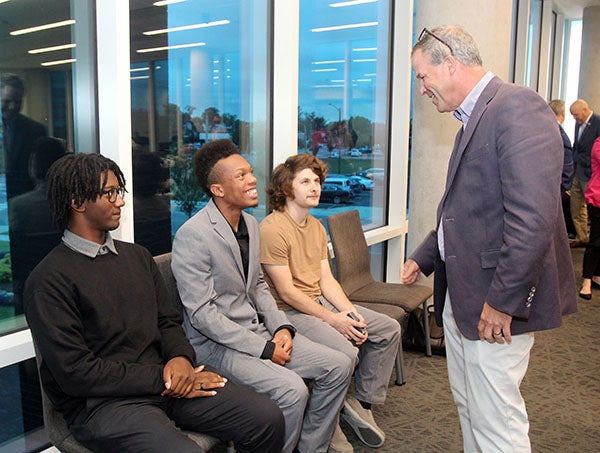Board of Trustees hears from students about their experiences at ECU
East Carolina University students shared how university support and resources are contributing to their successes in presentations to the ECU Board of Trustees, who met Thursday and Friday.

Chancellor Philip Rogers speaks during the Board of Trustees meeting on Friday. (Photo by Rhett Butler)
On Friday, Chancellor Philip Rogers said he especially enjoyed a presentation on the student life cycle because it knits together many of ECU’s strategic priorities, including student success, social and economic mobility, and workforce success — “All goals we seek to advance together with a ‘One ECU’ mindset,” he said.
Rogers announced that ECU welcomed nearly 5,600 new undergraduate students this year, an increase of 4% over last year. The university saw an 11% increase in out-of-state students this year, while retention rates for first-year and transfer students continue to rise, he said.
On Thursday, trustees learned how philanthropy is tied to student success from students Molly Baile, Jarobi Clark, Christine Chan and Noah Presley at the Athletics and Advancement committee meeting. The students all earned scholarships to attend ECU. Philanthropic support allowed for 2,200 scholarships to be awarded at ECU this year.
During the University Affairs committee meeting, administrators recognized three students — Rudar Ricks, Nehemiah Thomas Flournoy and Ian Taylor — who stopped to help another student, Sam Cordier, during a recent medical crisis on campus.
“They not only stopped to help him, they did the right thing, they got him into the right position. They ran into student health to get help, and then they stayed with that student until EMS came,” said Dr. LaNika Wright, executive director of Student Health Services. “You knew what to do and you stayed with him, and we thank you for being good Pirates.”
Along with Wright, ECU Provost Robin Coger, Vice Chancellor for Student Affairs Brandon Frye, and Sharon Paynter, acting chief research and engagement officer, presented information on the university’s efforts to adapt to the increased accessibility of artificial intelligence, to address student mental health, and to drive regional transformation through programs such as RISE29 and NCInnovation.
In the Strategy and Innovation committee meeting, student William Dong discussed the nine internships he has had and how he is currently working four jobs to pay his way through school. He graduates in December. The committee also heard about a recent marketing survey that helped identify ECU’s “personality.”

ECU Trustee Dave Fussell talks with students, from left, Nehemiah Thomas-Flournoy, Rudar Ricks and Sam Cordier in the Main Campus Student Center. Ricks and Thomas-Flournoy were honored during a meeting for helping Cordier during a medical crisis. A third student, Ian Taylor, also helped but was unable to attend the meeting. (Photo by Ken Buday)
Scott Ochander, chief leadership strategist and partner with Carnegie, a higher education marketing and enrollment strategy company, said workshops and surveys of ECU faculty, staff, current and prospective students, their parents, and others had determined ECU has the personality of a proud advocate and compassionate provider, is an institution where people can collaborate, and strives for transformative innovation for the region. Carnegie assigns a color to each of its 10 human-like traits, or archetypes. Coincidentally, “provider” and “innovator” are purple and yellow, respectively.
Those purple and gold traits help to inspire and drive ECU’s future-focused, innovation-driven work. ECU will continue to lead the way in multimillion, collaborative projects recently approved in the new state budget, Rogers said.
One the most significant state investments is a $410 million allocation to transform rural health care in North Carolina, with ECU and ECU Health at the center of this work, Rogers said.
The NC Care rural health initiative will include: $50 million for a new children’s behavioral health facility at ECU; $35 million for a new medical examiners’ facility; and funds for health care stabilization investments, rural care centers and an integrated network to support rural health care. “These are, in my estimation, the most significant investments in rural health care in our state’s history,” he said, thanking trustees and others at ECU for their advocacy efforts.
ECU also will serve as the lead agency of an eastern region innovation hub funded by a $500 million state allocation over the biennium. The project will support universities in transitioning research and innovations into commercialized products for industry, which will fuel economic growth, Rogers said.
In other action, trustees approved the following in its consent agenda on Friday:
- Naming the plaza at Clark-LeClair Stadium in front of the main gate in honor of Earl Boykin; naming a third-floor meeting room in the Main Campus Student Center in honor of Blair Blacknall; and renaming the Hitachi Astemo Inc. System Technology Controls and Instrumentation Lab to reflect the company name change from Keihin Carolina System.
- Purchasing two properties, at 2325 Stantonsburg Road and 402 Bowman Gray Drive, from the ECU Real Estate Foundation. The properties are contiguous to ECU properties. The 3.38-acre parcel on Stantonsburg operates as ECU Health Neurosurgery and Spine Center, and will be purchased for $800,776. The .86-acre Bowman Gray Drive property operates as ECU Physicians MRI and will be purchased for $628,027.
- Establishing an investment policy for institutional trust funds. ECU has historically used only the state treasurer’s short term investment fund and has not requested approval of other investment options for institutional trust fund cash balances. This policy will afford the university the flexibility to maximize returns among the state treasurer’s short term investment fund, treasury bills, treasury notes and treasury.
- Selecting T.A. Loving Company of Goldsboro as the construction manager-at-risk for renovation projects at Jones and Legacy residence halls.
- ECU also will serve as the lead agency of an eastern region innovation hub funded by a $500 million state allocation over the biennium. The project will support universities in transitioning research and innovations into commercialized products for industry, which will fuel economic growth, Rogers said.

Javier Limon, student body president, speaks during the Board of Trustees meeting on Friday. (Photo by Rhett Butler)
MORE BLOGS